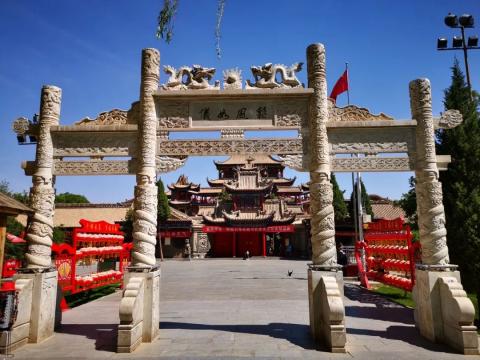I don’t believe in Buddhism but I like to see Buddhist culture and art and think about Buddhist theories.When I first arrived in Zhongwei, I heard that Baoan Temple could be visited for free, so I happily went. I never enter temples that charge a fee. Educational places charge fees behind closed doors, which goes against the original intention of religion. This is the reason why I don’t enter.Bao'an Temple is also known as the Gao Temple. Legend has it that because Zhongwei is high in the south and low in the north, there are often evil winds coming. In order to balance the yin and yang, a high temple was built to reconcile. From the terrain point of view, after entering from the mountain gate, the layers are raised. When you reach the main hall, you really feel like you are high up, so it is called Gaomiao.There is also a saying that Baoan Temple is divided into two courtyards, the lower one is flat and the upper one is on the platform. The lower courtyard is on the flat ground and is called Baoan Temple. The upper courtyard is on the platform and is called Gao Temple.
The archway and mountain gate in front of Bao'an Temple
Rear view of the main hall of Baoan TempleBaoan Temple is both exquisite and majestic. After visiting, I think there are the following highlights:Sophisticated and flexible architectural styleThe overall architectural layout of Bao'an Temple is compact, with a distinct sense of hierarchy, and the architectural style is complex, varied and exquisite. For example, the middle building in front of the main hall has six triangles on the left and right of each floor from the position of the brick archway in front.
Looking from the side of the mezzanine, there are only two corners on the left and right behind each floor, so each floor has a total of octagons. This asymmetrical octagon is extremely rare in ancient buildings in other places, reflecting the flexibility and flexibility of Ningxia's architecture in response to local conditions. The structure is symmetrical when viewed from the bottom of the mezzanine. The difference can be best seen when viewed from the side.
The three religions of Confucianism, Buddhism and Taoism are integrated into oneIn addition to Buddhist idols, there are Wenchang in the east and Guandi in the west. Within one building, different Confucian, Taoist and Buddhist idols can be enshrined in different layers. The most typical and centralized one is the exquisite brick-carved archway. The couplet in the middle is: "Confucianism, Buddhism and Taoism save me and others from here"; "The self-creation and self-transformation of heaven, earth and man are all here. here". The horizontal batch is: "The Supreme Dharma Bridge". The plaque on the right side door is "Tiangen", and the plaque on the left side door is "Moon Cave". Tiangen Yue Cave comes from the Taoist Book of Changes, which means the intersection of Yin and Yang. The so-called Tiangen Yue Cave means spring comes and stays. It has both the Taoist Yin-Yang Tai Chi meaning and the Confucian meaning of keeping everything in the middle and not pursuing extremes.
There is also a plaque with inscriptions on the north side of the archway, which also reflects the thoughts of the three religions. I won’t spoil it until you visit it in person. In addition, the twelve zodiac signs are also carved, which also represents the traditional Chinese twenty-four solar terms. It can be said that the archway is a typical embodiment of the integration of the three religions.There are 500 Arhats in the Arhat Hall. The shapes are lively and interesting, and they are quite exquisite. Especially Jigong, who is crowded in a corner at the door, has one bare foot, which is quite expressive. It is said that the Meditating Arhat is the son of Sakyamuni, and his eyes are full of confusion.
What impressed me deeply was the couplets in front of the Guanyin Hall. One couplet tells the truth of life. Whether you can understand the truth of life depends on yourself. It is useless to just worship the clay Bodhisattva.Most people are busy burning incense and worshiping Buddha on the surface. How many people can pay attention to and think about these philosophical couplets?
The underground palace that tourists like to play is not open due to line maintenance, but the music simulating the underworld has not stopped, and it is shocking when you listen to it occasionally. The positive aspect of Buddhism’s theory of karma should be to encourage people to do good.
The Bodhisattva is speechless and cultivates himself.The three religions are integrated into one, and the nine streams have the same origin.The unique Zhongwei Gaomiao is worthy of your stop and admiration. Its architecture, brick carvings, wood carvings, murals, couplets and statues, there is always something that will impress you and give you a moment of tranquility and insight.








